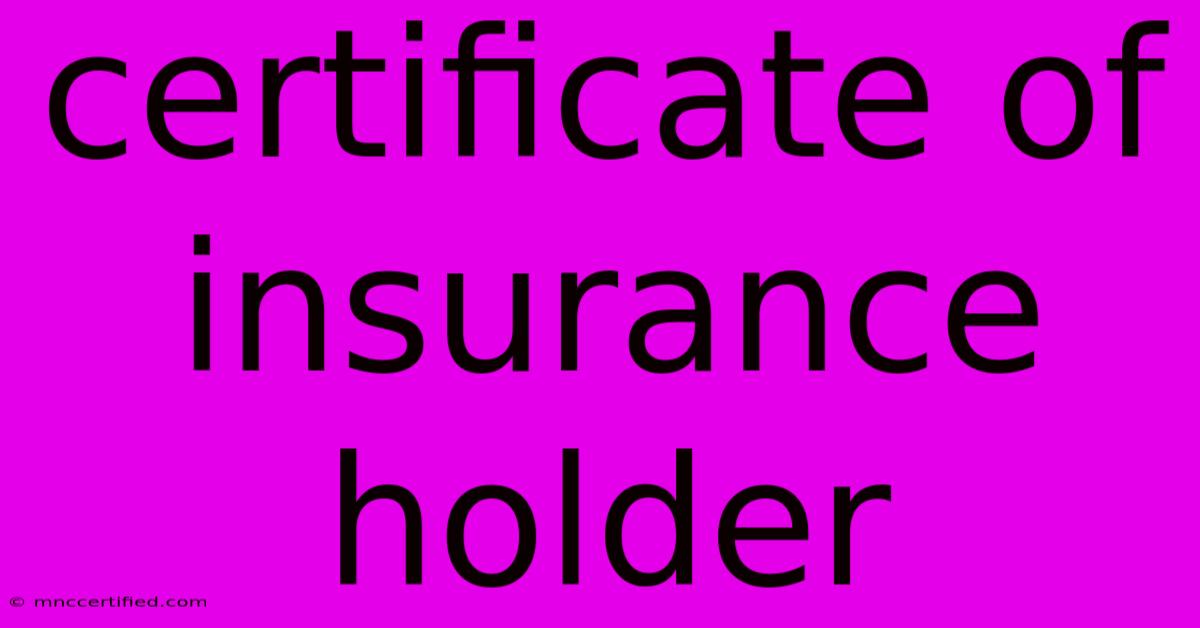Certificate Of Insurance Holder

Table of Contents
Understanding the Certificate of Insurance Holder: Your Role and Responsibilities
A Certificate of Insurance (COI) is a crucial document in many business and personal transactions. But what exactly is the role of the certificate of insurance holder? This comprehensive guide clarifies your responsibilities and how to effectively use and manage a COI.
What is a Certificate of Insurance Holder?
The certificate of insurance holder is the individual or entity who requests and receives a Certificate of Insurance from an insured party. They are not directly insured by the policy but benefit from the assurance that the other party carries adequate liability coverage. Think of it as proof of insurance, providing peace of mind. The holder uses the COI to verify the insured's compliance with contractual obligations or legal requirements.
Examples of Certificate of Insurance Holders:
- Property Owners: Requiring contractors to provide COIs before starting work on their premises.
- General Contractors: Demanding subcontractors to prove they have sufficient liability and workers' compensation insurance.
- Event Organizers: Ensuring vendors and entertainers carry liability insurance to cover potential incidents.
- Clients: Verifying that their service providers possess the necessary insurance coverage.
- Landlords: Protecting themselves from liability by requiring tenants with businesses to have adequate insurance.
Responsibilities of the Certificate of Insurance Holder
While the COI itself doesn't create an insurance policy, the holder has key responsibilities:
- Requesting a COI: Clearly specify the required coverages (liability limits, types of insurance, etc.) and the duration of the policy. Avoid vague requests; be precise.
- Reviewing the COI Carefully: Check the policy number, effective dates, named insured, types of insurance listed, and importantly, the coverage limits. Verify that the information matches your requirements. Inaccuracies are common. Don't hesitate to contact the issuing insurance agent if something is unclear or missing.
- Understanding Coverage Limitations: A COI is not a substitute for the actual insurance policy. It summarizes the coverage; the policy itself details the exclusions and conditions. Don't assume complete protection based solely on the COI.
- Maintaining Records: Keep the COI securely and systematically. This is essential for legal and financial protection.
- Notifying the Issuer of Changes: If you identify issues or discrepancies, contact the issuer immediately. If the policy expires or is canceled, you need to request an updated COI or find alternative arrangements.
Avoiding Common Mistakes with COIs
Several mistakes commonly occur regarding COIs. Avoiding them protects your interests:
- Accepting Expired or Invalid COIs: Always verify the effective dates. An expired COI offers no protection.
- Ignoring Discrepancies: Don't overlook inconsistencies in the COI compared to your agreement with the insured party.
- Not Specifying Requirements: Vague requests can lead to inappropriate or insufficient coverage. Be specific about your needs.
- Relying Solely on the COI: Remember, it's a summary, not a legal contract. You should independently verify the information with the insurer if necessary.
The Importance of Accurate Information
Accuracy is paramount. Both the issuer and the holder need to ensure all details are correct. Inaccurate information can lead to significant legal and financial consequences. If you suspect inaccuracies, contact the issuing insurance company immediately for clarification.
Conclusion: Protecting Your Interests
Understanding your role as a certificate of insurance holder is vital for risk management. By actively requesting, reviewing, and managing COIs appropriately, you significantly reduce potential liabilities and protect your business or personal interests. Always prioritize accurate information and don't hesitate to seek clarification when needed. Remember, a COI is a vital tool; use it wisely.

Thank you for visiting our website wich cover about Certificate Of Insurance Holder. We hope the information provided has been useful to you. Feel free to contact us if you have any questions or need further assistance. See you next time and dont miss to bookmark.
Featured Posts
-
Ron Has A Life Insurance Policy
Nov 23, 2024
-
Do Psychiatrists Take Insurance
Nov 23, 2024
-
Singer Khalid Speaks On Outing
Nov 23, 2024
-
Slater Grande Wicked Cast Drama Explained
Nov 23, 2024
-
New Kendrick Lamar Album Gnx Out Now
Nov 23, 2024